Even though link building as an SEO strategy has changed a lot in recent years, the link profile of your website is still an important ranking factor. And that’s exactly why you should take a close look at your backlinks. You can find out exactly what this means and which quality features play a role in your links in this article.
What exactly are backlinks?
A so-called “backlink” – also known as an “inbound link” – is when it is an incoming link from another URL. This means that an external link to your website has been placed on another website. It does not matter whether this backlink links to the main domain or to a subpage.
Nowadays, you often hear that backlinks are no longer relevant. However, this is complete rubbish. Backlinks are still essential when it comes to search engine rankings. Google, Bing and Co. use the backlink profile of every website as an indicator to categorise it for ranking purposes.
To put it simply, the more high-quality backlinks there are to your website, the higher it will be ranked by the search engines and the better it will rank in the search results.
Content marketing for advanced users: The 6 most important levers
Discover how to optimize your content marketing to reach the right audience, build trust, and achieve long-term success.
Not all links are the same
You should remember the following sentence right at the beginning: Not all backlinks are the same! There are numerous factors that differentiate between a good and a bad backlink. In some cases, the details of how backlinks are actually evaluated still remain a secret from Google.
There are basically two different types of links: internal links and external links.
Internal links
An internal link is a reference that points from a sub-page of the same or your own domain to another sub-page of this domain.
External links
An external link is a backlink that links from a subpage of another domain to a website or subpage of your own domain.
Building a backlink
Each link is set in HTML language and looks like this:
a href: This attribute is used in HTML to specify that it is a link.
“… ” : The URL between the inverted commas is the website that is linked to.
target: This attribute can be used to specify that the link should be opened in a new tab. However, this attribute is not mandatory.
>…<: The text between these two brackets is the so-called anchor text, which is visibly clickable.
What factors make a good backlink?
As mentioned at the beginning: not all backlinks are the same. There are numerous factors that make a good backlink – or that you can use to recognise a good backlink. You should therefore always check where you place a backlink and where your backlinks come from if they were not placed by you.
So that you can see what makes a good backlink, I would like to explain the most important factors to you.
Relevance
A good backlink should always be relevant. This means that it should come from topic-related websites. From Google’s point of view, backlinks that are “relevant” are favoured.
What does that mean? Let’s assume you have a website about football. Now you receive two backlinks. One backlink comes from a website about sport and the second backlink comes from a website about cats.
The backlink that has relevance, in our case the link from the page on the topic of sport, naturally has the higher relevance and is also categorised by Google.
Authority
Authority, also known as “Domain Authority” (DA for short), is an important factor for Google when it comes to assessing backlinks. The higher the value (0-100) of the “Domain Authority”, the stronger the backlink.
Many other factors are taken into account when assessing the authority of a domain. These include, among others:
- The age of the domain
- The number of incoming and outgoing links
- The quality of the backlinks to this page itself (backlinks)
In addition to the “Domain Authority”, there is also the so-called “Site Authority”, which is subject to exactly the same standards as the “Domain Authority”. In this case, the rating simply refers to a single subpage of the respective domain.
Naturalness
A very common mistake made when setting backlinks is to set unnatural anchor texts too often. This means that a backlink should be as natural as possible and flow seamlessly with the text in which it is integrated. For example, naked URL links such as “www.bloggiraffe.de” should be avoided. An anchor text such as “self-employed in online business” would be better. Depending on the form in which the word sequence can be integrated into the body text, you can – and should – of course vary here.
Of course, it always depends on the frequency of the link. If the domain is used “hard” as anchor text and placed countless times on external pages, there is a risk that Google will categorise this as spam. The same applies to always using the same keywords as anchor text. This will result in the domain being penalised. This should be avoided at all costs. For more information on anchor text, I recommend the detailed Anchor Text Guide by Nathan Gotch.
Traffic
The more regular traffic a website from which you receive a backlink has, the more “link juice” – i.e. link power – is passed on to your website. For you, this means that the search engines will classify this link to your site as more valuable than if a website with very little traffic links to you.
Placement
The correct placement of the backlink should not be underestimated. The more prominent the backlink is placed on a website and refers to your website, the higher its quality is rated.
What does that mean exactly? If the link is in the sidebar or in a footer, for example, it is usually only one of many links. In practice, this means that it is given less link power. However, if the link is placed relatively high up within an article, for example, it is given significantly more relevance.
Content length
In addition to the placement of a backlink, the length of the content in which the link is placed also plays a role. The longer the content, which Google already classifies as “more relevant” anyway, the higher the relevance of the link within this content.
The main prerequisite is, of course, that this content is well written and relevant for the search engines.
Managed WordPress Hosting
With our Managed WordPress hosting, you get a powerful, secure and easy-to-manage solution that quickly and reliably takes your WordPress project to the next level. Check it out!
SEO and backlinks
As already mentioned in some of the previous paragraphs, backlinks are essential for search engines such as Google and others to be able to categorise the quality of the respective website. It does not matter how many backlinks point to a page, but how good or bad the quality of these backlinks is.
If a website builds up a large number of unnatural backlinks over a short period of time, a so-called “Google Penalty” can occur in the worst case. This means that the website is completely excluded from the rankings. You should therefore regularly check which new backlinks are added and react to “bad” backlinks accordingly.
Because it also happens very often that you don’t set any backlinks yourself, but someone is trying to damage your website. If you find such links, you can have them devalued by Google. The “Disavow Links” tool is available for this in the Google Searchconsole: https://www.google.com/webmasters/tools/disavow-links-main.
To summarise from an SEO perspective, you should always make sure that backlinks pointing to your site are both natural and relevant to the topic. The more “trust” a website that links to your site has, the better it is for you.
The anchor text
I have already mentioned the “anchor text” above. This is an extremely important component when it comes to search engine optimisation.
On the one hand, this is the text that visitors see on a website, and on the other hand, this anchor text is also read by search engines. The anchor text should therefore always be unique and related to the linked page. See also “Naturalness”.
Dofollow, Nofollow, Sponsored & UGC Attributes
There are now a total of four link attributes that can be assigned to a link: dofollow, nofollow, sponsored and ugc. This allows you to give Google information about the relationship to the linked website. I would like to briefly explain below how these so-called rel attribute values differ from each other.
Follow links
The good news first. To set a dofollow link, you usually don’t have to do anything else. If the backlink is not labelled as “Nofollow”, it is automatically a “Follow” link.
With a dofollow link, the Google bot receives the signal to crawl the link, i.e. to follow it. This link has a positive effect on the ranking of the linked website. This is often referred to as passing on “link juice”.
Example:
Self-employed in online business
Nofollow links (rel=”nofollow”)
With a nofollow link, on the other hand, the Google bot receives the signal not to follow the link any further, i.e. not to crawl it. This means that this backlink has no effect on the link structure of the linked page, as it is not included in Google’s evaluation.
Example:
<a href=”https://bloggiraffe.de/” rel=”nofollow”>Self-employed in online business
Sponsored links (rel=”sponsored”)
The sponsored link or this link attribute should be used to identify links that have been placed on the basis of a consideration, such as purchased advertising, links, recommendations or similar.
Example:
<a href=”https://bloggiraffe.de/” rel=”sponsored”>Self-employed in online business
User-generated content (rel=”ugc”)
This link attribute should always be used when content is linked that was created by users of the linked page and not by the website operator itself. This is the case, for example, with comments on a blog or forum entries.
Example:
<a href=”https://bloggiraffe.de/” rel=”ugc”>Self-employed in online business
Link-Juice (Link Equity)
When the term “link power” or “link equity” is used, it means that a certain SEO authority or a certain trust of the page that sets the backlink is passed on to the linked website.
The higher this value or trust is, the more influence the backlink has on the search engine ranking of the linked page. The factors that I have already explained under “What factors make a good backlink?” play a decisive role here.
Tips for more backlinks
If you want to actively build backlinks for your website, there are various ways to do this. I would like to introduce you to the most popular ones below.
Guest article
The classic way to build backlinks is to publish guest articles on other relevant websites. In other words, you search for suitable websites and ask whether you can write and publish a high-quality article on the topic.
The prerequisite is, of course, that you are also allowed to place a backlink to your website in this article. After all, you are also providing high-quality content for the readers of the respective page.
Interviews
The procedure for interviews is similar to guest articles. The only difference is that you ask a website operator for an interview, which you then publish on your website. How do you benefit from this?
It’s very simple! After publishing the interview on your website, you ask the interviewee to share your interview with you, for example on social media channels or perhaps even in a short article.
Mention websites
A very simple and usually effective method is to regularly mention relevant websites in your posts – whether on your website or on social media channels. This generates attention and you can hope that the website mentioned will also mention or link to you.
Comments
A popular (and sometimes controversial) method is to set backlinks within comments. There are numerous topic-relevant blogs that allow commenting on posts. Unfortunately, this function is often exploited by SEO spammers. If you comment, you should of course not only be looking for a backlink, but also read the post seriously and respond to the content. Most website operators immediately recognise generic comments that are only written for SEO purposes and mark them as spam.
How do you treat your comments?
Johannes Mairhofer has summarized more information and tips for managing your comments in WordPress in his blog article on the topic.
Find broken links (“Broken Links”)
You can search for broken links on websites that are relevant to you. You then have the option of writing to the website operator and asking whether they are interested in replacing the broken link and linking to you there instead.
You can use the free “Deadline Link Checker” tool for this, for example.
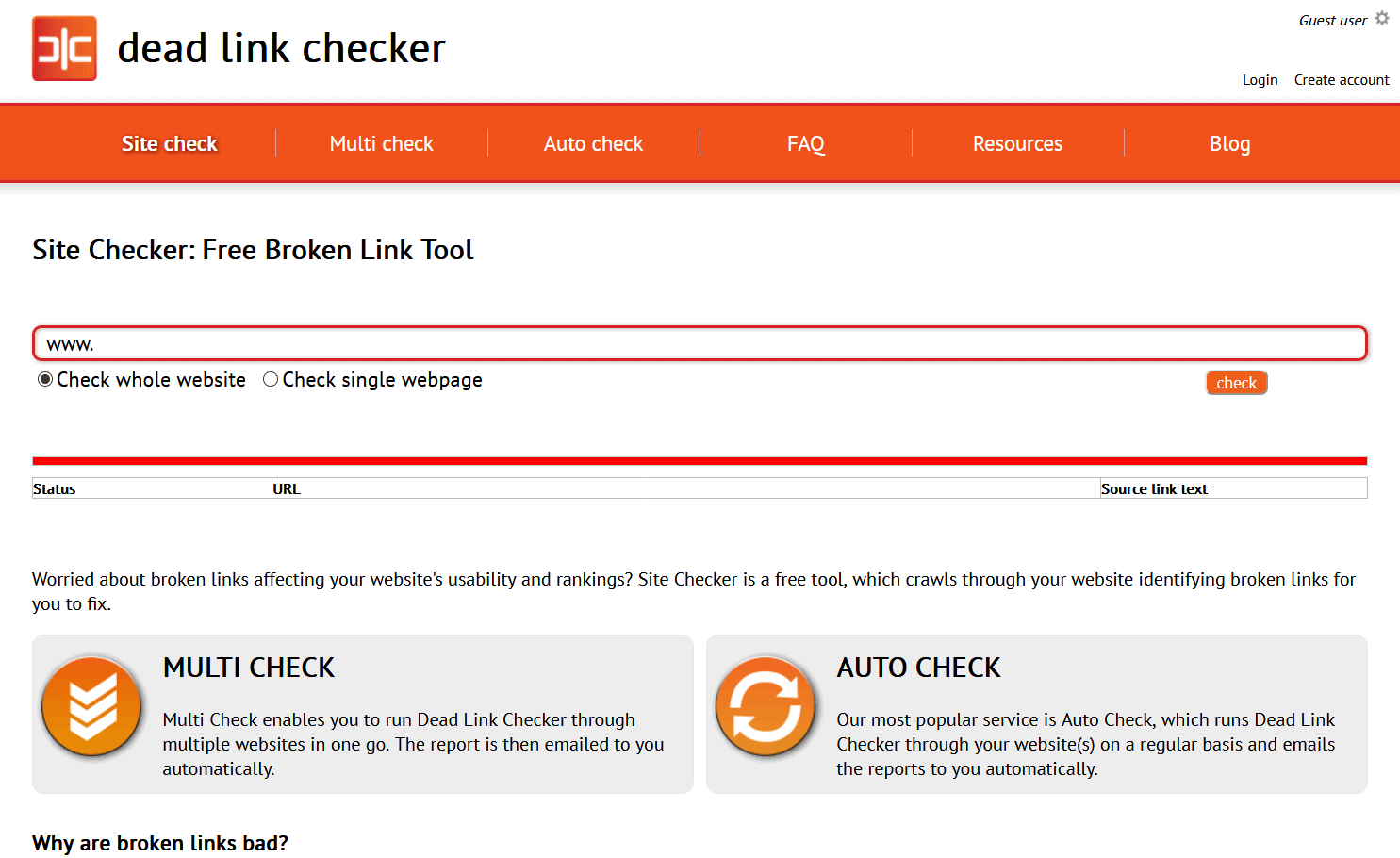
Here you can enter the relevant URL and have it checked for broken links. If you find a link that fits the topic and is actually faulty, you should contact the website operator once and suggest your website for linking.
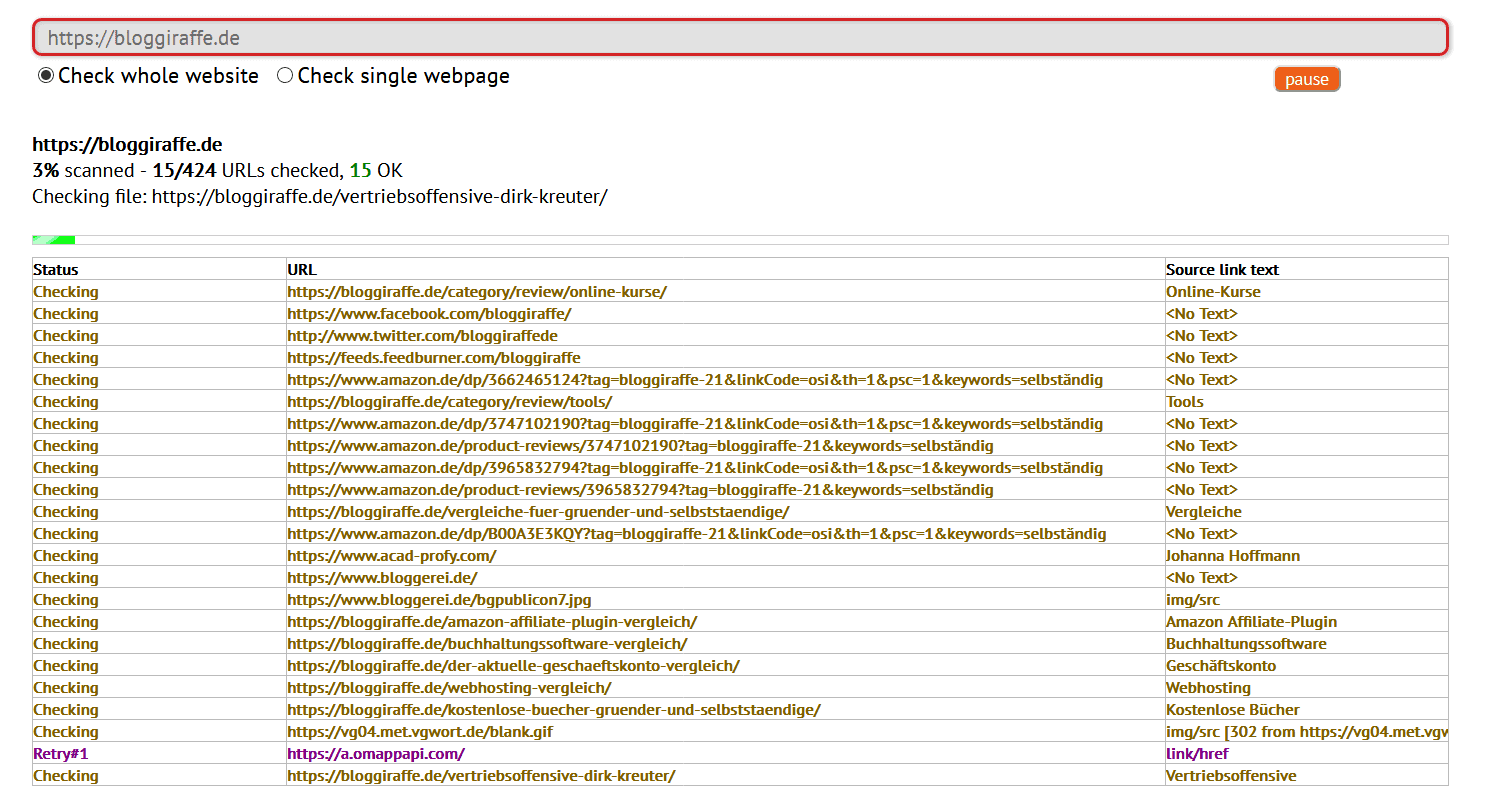
High-quality content
My absolute favourite way to generate high-quality backlinks is to create high-quality content yourself. Of course, you have numerous options for this. Be it the creation of a great article, infographics, videos and much more.
Of course, you can also use social media effectively for this. In other words, post videos on YouTube, share posts on Twitter, Facebook or Instagram. Of course, there should always be a link to your website here. There really are numerous options available to you here.
For whom are backlinks important?
This question can be answered in one sentence: For all those who want to be visible in search engines such as Google and Co.
For those who run a blog or website for personal reasons, it may not matter where they rank in the search engines. However, if you generate income with your website or blog or offer services or products on your site, then good backlinks are essential. After all, you want to be found as easily as possible when someone searches for your product or service.
In the latter case, it is therefore important to build a backlink structure that is as natural and high-quality as possible so that Google categorises your website as relevant as soon as search queries are entered in Google.
Check backlinks yourself
You have two good and free options for checking the backlinks or backlinks to your website yourself. The Google Search Console is of course the best way to do this. If you have entered your website here, you can view the most linked pages and top referring domains.
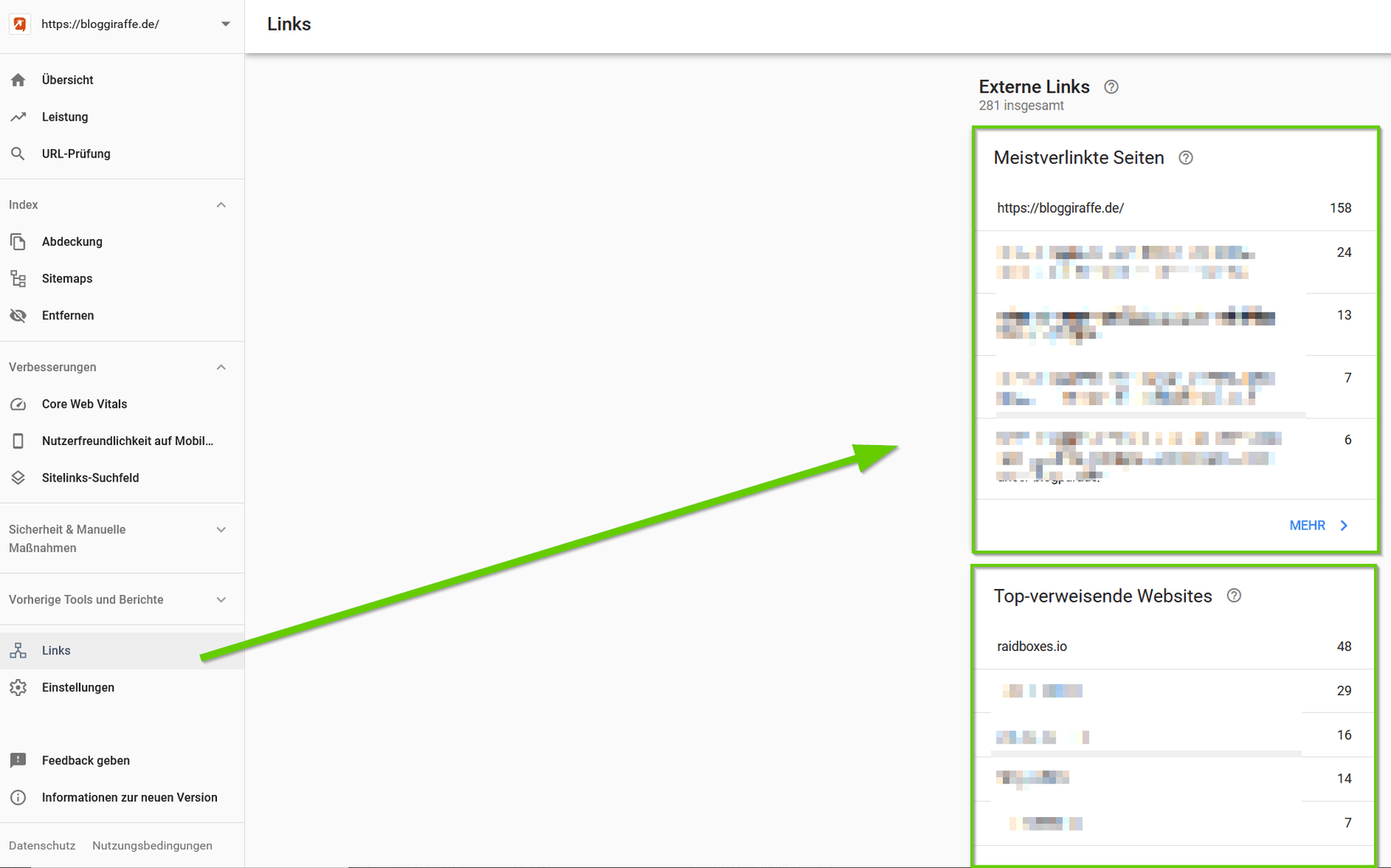
If you click on the respective page here, you will see an overview of the URLs that link to it.
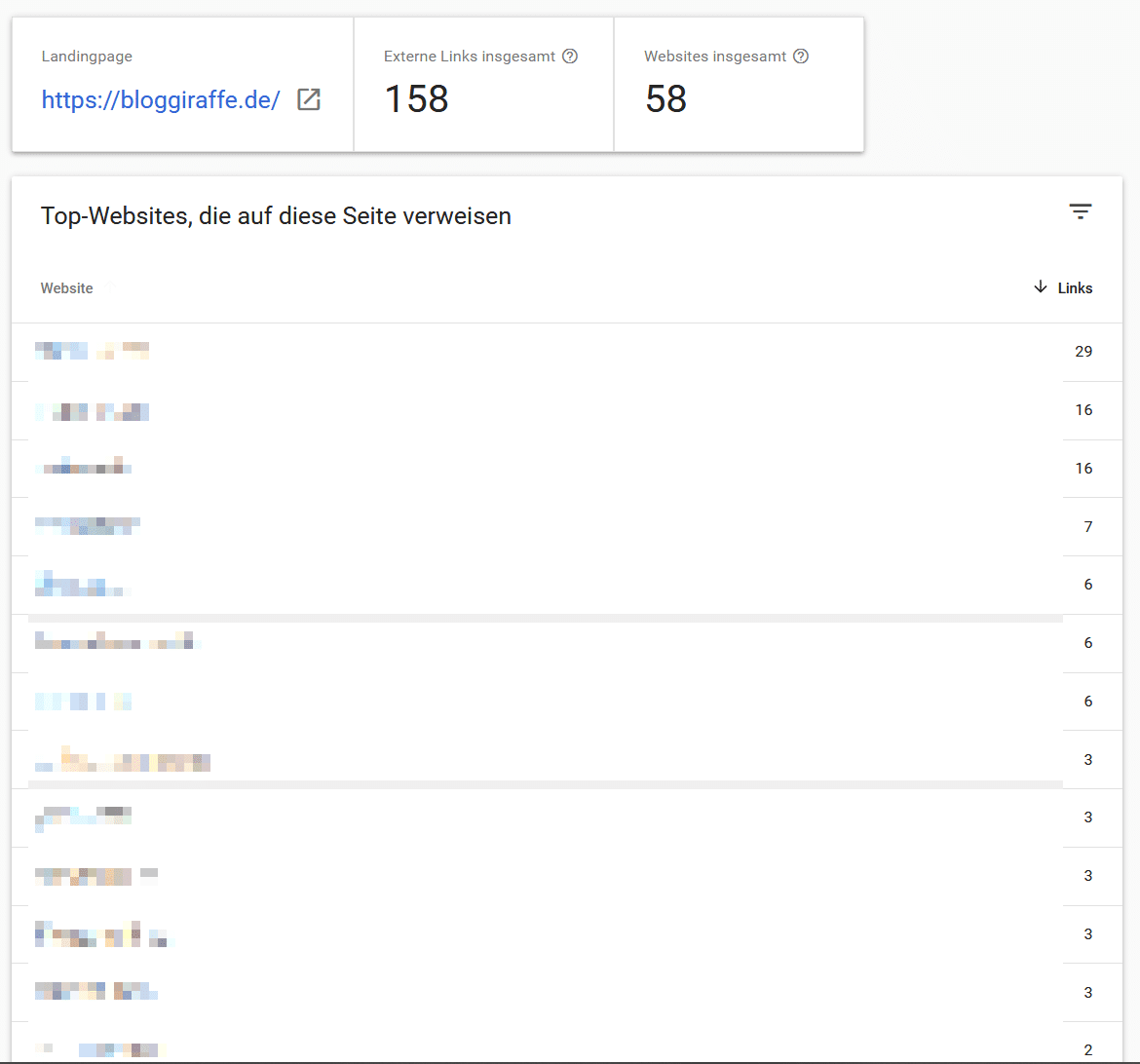
The same of course applies to the top referring websites. If you click on the respective website here, you will get an overview of the pages to which it has a backlink.

Another free alternative to Google Search Console is the backlink checker from Ahrefs: https://ahrefs.com/de/backlink-checker.
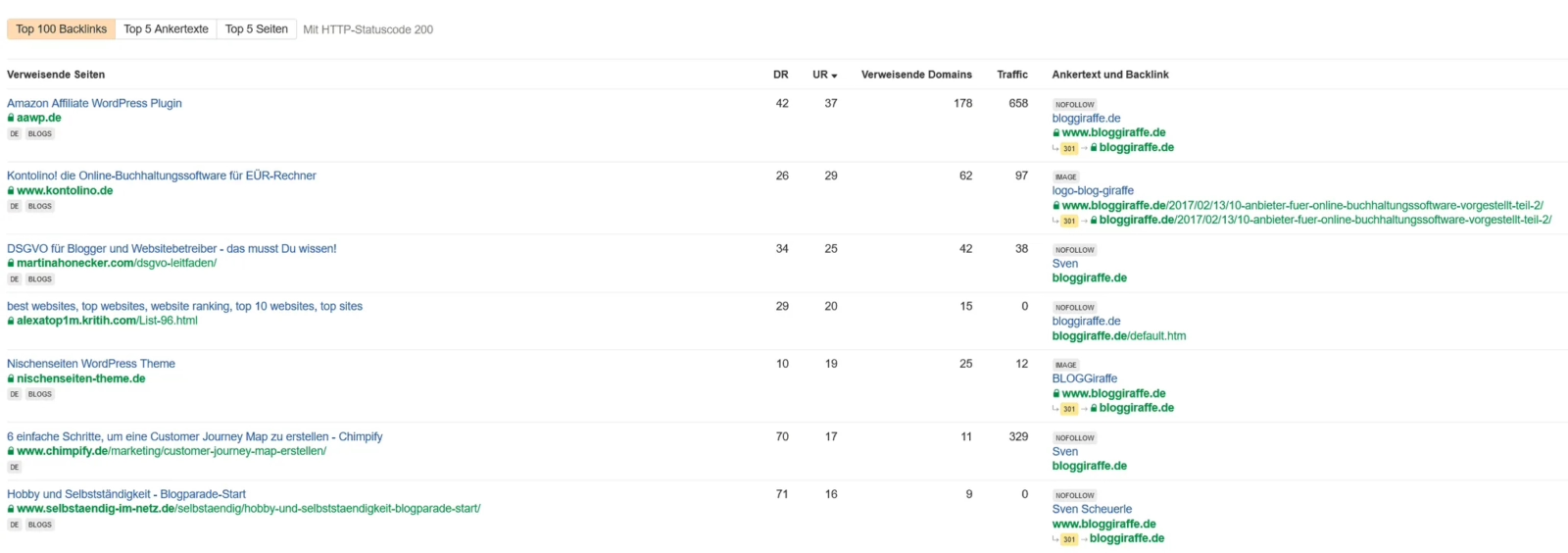
In this tool you can view your top 100 backlinks and carry out corresponding analyses.
Conclusion
Backlinks still play an essential role for every website operator today. Even if Google increasingly favours high-quality content, backlinks remain an important factor in signalling the value of a website to Google.
To ensure that this works effectively, I recommend that you always keep an eye on your backlinks. If you actively set backlinks yourself, pay particular attention to the factors mentioned above. However, if a backlink does not originate from you, you must check whether or not it fulfils the requirements for high-quality linking. If it does not, you should have it devalued via the Google Search Console so as not to damage your backlink profile.
Your questions about backlinks
Do you have any feedback or questions for Sven on the above points? Then please feel free to use the comment function. For more insights on WordPress, web design or online business, follow Raidboxes on Facebook or LinkedIn – or subscribe to our newsletter.


Leave a Reply